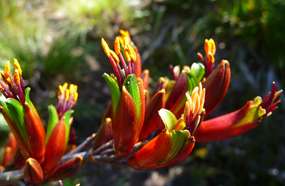(Medical Xpress)—New research from the University of Reading, The Royal Botanic Gardens, Kew and Imperial College London published on 10 September in the Proceedings of the National Academy of Sciences (PNAS) could allow biopharmaceutical companies to distinguish groups of plants most likely to be beneficial to our health.
Throughout history plants have been used for their medicinal properties. According to the World Health Organisation approximately 25% of medicines are plant-derived and many pharmaceutical drugs are derived from plants that were first used in traditional systems of medicine, including drugs used in the treatment of breast cancer and heart disease.
As plant populations are decimated by changing land use, climate change and over exploitation, identifying the species most likely to contribute to future health needs could hardly be more urgent or significant. But with tens of thousands of species used by different cultures, identifying those likely to be of benefit is a time consuming and expensive process.
By studying and recording over 1,500 medicinal plants reported to have health benefits in three continents, the researchers created a family tree of plant species for each area, demonstrating how medicinal plants relate to each other. They then combined the trees to create a 'super' family tree representing 20,000 species to reveal which medicinal plants from different areas were related.
The results were extraordinary. Not only did the researchers find examples of very closely related plants being used as medicines in different parts of the world, they also discovered they were being used to treat the same ailments. Furthermore, they found that many modern day drugs come from these groups of closely related plants.
This study, the first of its kind, could enhance the success rate of companies involved in bio-prospecting, the search for new, economically-valuable biological products. Plants have a vital role to play medically. Paclitaxel, which is used as a treatment for breast cancer, derives from yew trees, while foxgloves contain a key ingredient used in cardiotonics which treat heart failure.
Dr Julie Hawkins, from the School of Biological Sciences at the University of Reading, said: "Our study examined plants known to be used medicinally in Nepal, New Zealand and the Cape of South Africa, areas unlikely to have exchanged information about medicinal properties of plants so would be using these plants after discovering them independently. We found that plants known to be useful in all three separate regions were from groups that were closely related.
"Across the whole of the super tree we found many groups of related plants that had been independently discovered. One example is that plants from the soapberry family are used in Nepal, the Cape of South Africa and New Zealand to treat gastro-intestinal problems. It seems these treatments, using closely related plants, have been independently discovered. Additionally, the study showed that other closely related plants that are not used by traditional medicine in these regions, such as maple or lychee trees, could also have medicinal properties.
"Our super tree will help companies involved in bioprospecting narrow their search for plants with medicinal properties which could lead to new disease fighting drugs." continued Dr Hawkins. "It's incredibly exciting to think that communities around the world that weren't in contact with each other have sampled related plants and are using them to treat the same things."
Co-author of the study, Professor Vincent Savolainen from the Department of Life Sciences at Imperial College London, and RBG Kew, said: "This super family tree of medicinal plants will help create new opportunities to make modern medicines from the active ingredients in traditional medical treatments. I strongly urge biomedical scientists to use our study to speed up their search for innovative new medicines, but in doing so they have to fulfil a duty to the people who discovered the beneficial effects of such traditional medicines.
"Many have signed up to the International Convention on Biological Diversity, which requires individuals and companies to acknowledge the origins of their discoveries. Now, more should be done to follow this through, for example by sharing the financial benefits of a commercialised drug, or involving traditional practitioners in the development of modern medical treatments in their countries of origin."
Dr Haris Saslis-Lagoudakis, who contributed to this research as part of his PhD thesis, said: "Traditional medicine has been neglected in recent years in research on the discovery of new medicinal plants and pharmaceutical drugs. It is fascinating to demonstrate that traditional knowledge that has been compiled through centuries by local communities around the globe could hold the key to curing modern-day diseases."
More information: "Phylogenies reveal predictive power of traditional medicine in bioprospecting," by C. Harris Saslis-Lagoudakis et al. PNAS, 2012.
Journal information: Proceedings of the National Academy of Sciences
Provided by University of Reading


















